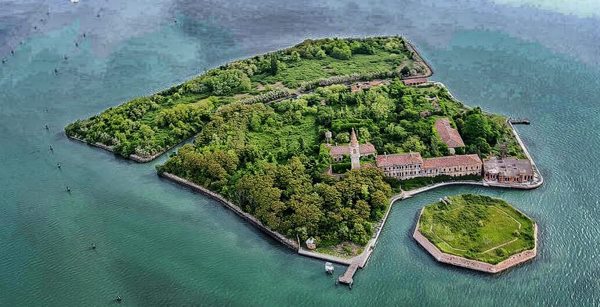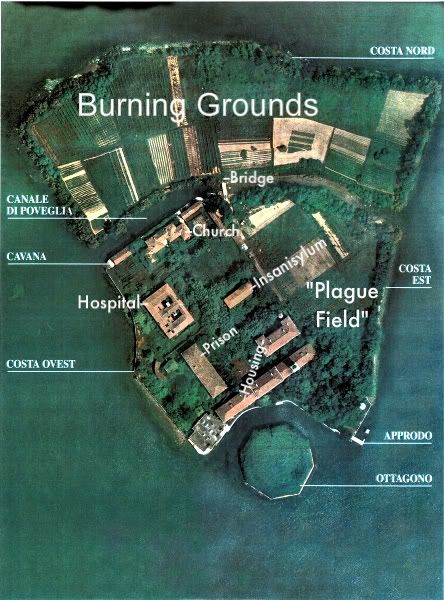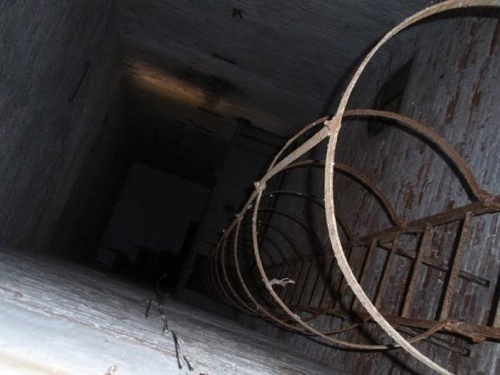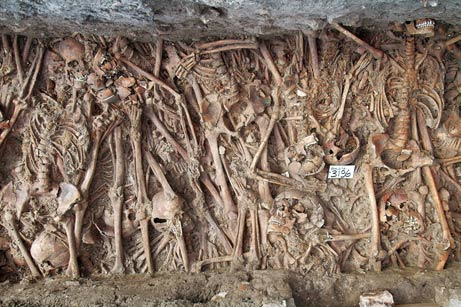

Location: Poveglia Island, 3 miles South of Venice Map
Area: 7.25 acres
Buildings: 11 structures
Closed (technically): due to poor state of buildings
Poveglia Island is a small island situated just 3 miles South of Venice in the Venetian Lagoon in Italy. Poveglia Island consists of two parts divided by a canal that has a single bridge over it. This abandoned plot of land is off limits to the tourists due to the condition of the buildings that are falling apart, but it does not mean people don't find ways to get to the island. Its main attraction is the remains of the mental institution that were opened in 1922 and closed in 1968. Many reports of paranormal activity have surfaced that keep the fame of Poveglia Island as one of the most haunted places in Italy alive and persistent. Several reality shows were filmed at this location including Ghost Adventures, Scariest Places on Earth and many more. Hospital that contains about 11 buildings on its grounds is considered to be one of the most haunted places.
Why is Poveglia Island off limits?
Currently there is reconstruction project going on the grounds of Poveglia Island by the Italian government. Dilapidated buildings are secured and reconstructed to restore to its previous significance. Additionally attempts are being undertaken to secure beaches of the island from further erosion into the sea. Hopefully it will be open soon for legal visits by tourists.

Ancient hooks and fossil clam shells are found on Poveglia, but there is no trace of a permanent settlement.
Like all the islands of the Venetian lagoon, Popilia was part of the
maritime Veneto, itself part of Byzantine Italy, but was only a fishing
village until 864 when, according to Pompeo Gherardo Molmenti, about two
hundred Venetian families, supporters of the doge Pietro Tradonico
killed following a plot of Venetian nobles, came to take refuge there.
They had barricaded themselves in the Doge's Palace until their lives
were saved and a land to settle in. Orso Partecipazio, the successor of
the assassinated doge, granted them the island and a number of
privileges.
In June 1305, Tolberto da Camino, Iacopo Ricco, Guido
Avogaro and Pirolino de' Costantini, ambassadors of Gerardo and Rizzardo
da Camino and the municipality of Treviso, asked the Doge of Venice to
hand over to them some guilty of "machinations" against da Camino and
the municipality of Treviso. The Doge replied that he was sorry, that he
could not "hand them over as foreigners", but that he had already had
them arrested in Poveglia where they would be tried.
In less than
a century, the community of Poveglia grew: more than eight hundred
houses were built and the island became rich in vineyards, fishponds and
salt marshes. In 1378 it had become an autonomous republic ruled by a
ducal Gastaldo and seventeen Consiglieri. The gastaldo represented the
island opposite the Palazzo Ducale.
In view of the importance
assumed by the population of the island, on December 30, 1339, by a
resolution of the Great Council, the podestate was charged with
rendering justice, and Pietro Lando was elected one of the nine
podestates of the Dogado.
The new podestate had jurisdiction over
Malamocco, Pellestrina and Pastene. Every Monday he had to go to
Malamocco and another day of the week to Pellestrina. But since the trip
to Pellestrina was long and unpleasant in winter, it was decided in
October 1341 to give it up. The podestate was elected for a year and
this man aged between 20 and 50 was assisted by a notary and four
famuli.
In addition to civil and legal jurisdictions, he had to
ensure the protection of the fragile environmental balance, take care of
the condition of the vines, and maintain the docks and the banks. He was
also in charge of ensuring the regularity of the entrances to the city,
Poveglia being the obligatory point of passage to go to Venice then.
In September 1375, in particular, he had the inhabitants of Chioggia
arrested who were transporting contraband wine to Venice at night.
The decline of Poveglia began after 1379, because of the Chioggia
War. The population decreased significantly, but those who remained on
the island were never deprived of their former privileges, such as tax
exemption.
In the sixteenth century, the island was transformed
into a lazaretto (the Lazzaretto Vecchio and the Lazzaretto Nuovo were
saturated), allowing to welcome people sick of the plague. Local rumors
say that more than 160,000 of these people were buried there. Large pits
would have been dug there and imposing pyres installed in order to burn
the bodies. Fearing that the bacillus could spread, some people who
showed less severe symptoms were reportedly sent there after being
separated from their families.
In the eighteenth century, two laws were promulgated so that ships
suspected of having cases of plague on board could remain in quarantine
in front of Poveglia.
"Permitendo circostanze del tempo e
dell'acqua, obbligato ammiraglio Malamocco condur bastimenti in una sol
volta al loro luogo: li provenienti da luoghi infetti in Fisolo, quelli
di minor sospetto in Poveglia [...] »
"Con li metodi prescritti
da terminazione 5 febbraio 1760, tradur debbano bastimenti soggetti a
contumacia di giorni 40 nel Canal di Poveglia, li soggetti a giorni 28
in quello de' Marinis"
In 1777, the island came under the
jurisdiction of the Magistrato alla Sanità.
The ships, their
crews and passengers did not come directly to the Lido, but used the
canale di Poveglia and the Teson, and passed through Poveglia, where the
large building served as a lazaretto. In 1793, a crew of a "tartarella
idriotta infetta di peste" was isolated there, but no deaths from the
plague were recorded. In the report of an engineer dated April 20, 1842,
we can read that "The lazaretto of Poveglia was gradually brought to
this use, with the construction of spacious buildings with imperative
conditions for health" ; new wells are being built to avoid any possible
contamination.
In the eighteenth century, there was still a
church dedicated to San Vitale on the island, which had a famous
crucifix, now preserved in the Malamocco church, and a painting by
Titian, but being dilapidated, it was closed in 1806 and later
demolished. Only the pointed bell tower has been preserved, which was
transformed into a lighthouse when the island served as a shelter for
ships in quarantine.
During the nineteenth century, during the Austrian era, the island
was transformed into a quarantine center, a use maintained by Italy
until the Second World War, during which it was occupied by the soldiers
of fascist Italy and served as a dying place for prisoners of the
Italian resistance and a morgue.
After the war, restored Poveglia
hosts a convalescence and rest home for the elderly until 1968.
In the twenty-first century, many urban legends are spread about
Poveglia by ghost hunters, especially Anglo-Saxons, according to which
it would be "haunted", to the point that it becomes a tourist business.
The Daily Telegraph states that "Poveglia is considered, by some, as a
place renowned for paranormal phenomena", and adds that the island is
even "considered one of the most haunted places in the world": this
poses such problems that since 2004, the island has been closed to
tourists. Since 2004, the main activity of the island is agriculture,
especially viticulture and fishing.
In 2014, the Italian government, the owner of Poveglia, announced its
intention to separate from the island, in accordance with the policy of
selling state assets aimed at reducing the indebtedness of the Italian
state. Poveglia is auctioned for an emphyteutic lease for a period of
ninety-nine years by the Agenzia del demanio. To prevent this historic
place from becoming a resort for the most fortunate on the planet, the
Venetians have created an association, "Poveglia per Tutti". To try to
win the auction, everyone can participate up to € 99 and thus have their
share in the future of the island.
Despite the mobilization of
the Venetians to raise 440,000 euros, the auction was won by businessman
Luigi Brugnaro, with a bid of 513,000 euros, in May 2014. The offer of
this buyer was nevertheless rejected in June 2014 by the Italian public
agency in charge of the sale which had thirty days to validate or not
the purchase offer. This one appeals and intends to cover Poveglia with
luxury hotels.
421 - The island was a refuge for people who fled from Padua and Este
during the barbarian invasions.
809 - Following the invasion of
Pepin, the inhabitants fled to the Rialtine islands.
864 - Doge Orso
Partecipazio, to put down the revolt of the servants of the murdered
Doge Pietro Tradonico, allowed them to live on the island of Poveglia
and gave the community many privileges. In the following centuries the
island prospered both economically and demographically so much that it
was ruled first by a tribune, then by a ducal steward and finally by a
Podestà.
1379 - During the war of Chioggia, the fort called Ottagono
was built to defend the island and is still visible today; for security
reasons the inhabitants were transferred to the Giudecca.
1527 - The
Magistrato alle Ragioni Vecchie, seeing the abandonment of the place and
the buildings following the war of Chioggia, offered it to the
Camaldolese to build a convent, but they refused.
1661 - It was
proposed to the Povegliani to rebuild the buildings but they also
refused.
1777 - It passed under the jurisdiction of the Health
Magistrate, and became a transit and health control station for the
crews of vessels and for the expurgation of goods.
1793/1799 - Due to
a plague epidemic that broke out on two ships, the island was
temporarily used as a hospital.
1805/1814 - It was definitively used
as a hospital. Following the Napoleonic edict, the church dedicated to
San Vitale was demolished and the adjacent bell tower was used as a
lighthouse. - Start
20th century - The island was equipped as a
maritime station for the quarantine of crews and passengers coming from
ports where cases of epidemics had occurred. In the following years, the
health complex was converted into a convalescent home for the rest home.
1968 - This last use was abandoned and after a brief period of
abandonment the island was given in concession to a farmer who
cultivates the uncovered spaces. The buildings, due to the total lack of
maintenance, are rapidly falling into disrepair.
1997 - The CTS draws
up a project for the island which envisages the construction of a
complex for youth accommodation and cultural enjoyment.
1999 - The
Ministry of the Treasury excludes Poveglia from the list of assets to be
put up for sale and hands it back to the State so that it can be granted
to the CTS. In this context, the Consorzio Venezia Nuova will have to
proceed with the renewal of the margins. I visit.
Octagonal Fort
This defensive structure, built in 1645 as one of
five forts to protect the lagoon entrances from naval threats, is
the only surviving example of its kind. Located on a small
artificial islet adjacent to the main island, it's an octagon-shaped
fortification once armed with artillery. Now abandoned and
unconnected to the rest of Poveglia, it's overgrown with grass and
serves no current purpose, contributing to the island's eerie,
isolated atmosphere.
Bell Tower
Dominating the island's
skyline, this 12th-century tower is the most prominent and visible
structure, originally part of the Church of San Vitale. After the
church was demolished in 1805-1806 under Napoleon's orders, the
tower was repurposed as a lighthouse, with a clock added in 1745.
It's now in disrepair, with dilapidated stairs, missing steps,
collapsed floors exposing rusted rebar, and graffiti covering the
walls. Legends associate it with hauntings, including claims that
the asylum's director jumped from it after performing cruel
experiments, though these stories lack historical verification and
stem from modern media.
Psychiatric Hospital and Asylum
Buildings
Converted from existing structures in 1922, these
served as a mental asylum until 1946, then as a long-term care
facility and nursing home until closure in 1968. The complex
includes hospital wards, administrative buildings, staff housing,
and a visible "Reparto Psichiatria" (Psychiatric Department) sign.
Interiors feature abandoned beds, mattresses, industrial kitchens,
machinery, hallways with rubble, and ominous rooms with a heavy
atmosphere. The buildings are derelict, with collapsed ceilings,
stairs, and walls, all enveloped in ivy and vegetation. Rumors of
lobotomies and patient sightings of plague victim ghosts add to its
haunted reputation, though unsubstantiated.
Other Notable
Sites
Church of San Vitale Ruins: Only remnants exist after its
destruction in the early 19th century; a unique crucifix from the
site is preserved in nearby Malamocco.
Cavana (Boat Shelter): A
surviving structure used for storing boats, now part of the
overgrown ruins.
Prisons: Additional abandoned structures on the
island, likely from its quarantine era, now in decay.
Plague
Pits: Scattered mass graves from the 18th-19th centuries, hidden
amid fields and trees, marking the final resting place for thousands
of victims.
Poveglia Island, often called the "Island of Ghosts" or one of the world's most haunted locations, is shrouded in tales of supernatural phenomena that have captivated paranormal enthusiasts and deterred visitors for generations. Reports of eerie occurrences include disembodied screams echoing across the ruins, shadowy apparitions wandering the overgrown paths, physical assaults by unseen forces, and an pervasive sense of dread that overwhelms those who dare to set foot there. Legends speak of restless spirits trapped in eternal torment, manifesting in chilling ways that blend auditory hallucinations, visual specters, and poltergeist-like activity. While many accounts stem from urban legends amplified by media, others come from firsthand experiences documented by investigators, with no shortage of claims involving electronic voice phenomena (EVPs), sudden temperature drops, and objects moving on their own. Skeptics argue these are products of suggestion, environmental factors like wind through decaying structures, or outright fabrications for entertainment, but believers point to consistent patterns in reports as evidence of something otherworldly.
One of the most enduring legends revolves around a "mad doctor"
figure, said to haunt the island's bell tower. According to the story,
this spectral entity was driven insane by relentless visions of
tormented souls and incessant whispers, culminating in a fatal plunge
from the tower—only for his spirit to be ensnared by a mysterious fog or
vengeful entities below. Some versions claim his body was sealed within
the tower's walls, and visitors report hearing agonized cries or feeling
an invisible push near the structure, as if reenacting his demise. The
tower itself is a focal point for hauntings, with claims of bells
tolling on windless nights, shadowy figures climbing its dilapidated
stairs, and EVPs capturing pleas for mercy.
Another pervasive myth
involves plague-era spirits, depicted as moaning apparitions or
emaciated shadows that roam the fields and ruins. These entities are
said to appear as misty forms rising from the ground, accompanied by the
scent of decay or burning, and are blamed for poltergeist activity like
stones being hurled at intruders or doors slamming shut without cause. A
particularly chilling legend warns against removing even a handful of
soil from the island, as it supposedly carries a curse—those who do are
haunted by nightmares, apparitions in their homes, or unexplained
misfortunes until the earth is returned.
Specific named ghosts add
personal horror to the lore. "Little Maria," a child spirit, is
described as a small, weeping figure in tattered clothes who wanders the
beaches, calling out in a faint voice that draws people into dangerous
areas before vanishing. "Pietro," an amputee entity, is linked to sounds
of a phantom wheelchair rolling through empty corridors, sometimes
accompanied by dragging footsteps or labored breathing. Other tales
include vampire-like beings from older folklore, where exhumed figures
with bloodied mouths were believed to feed on the living, leading to
rituals that supposedly bound their spirits—but failed to silence their
nocturnal howls.
Paranormal investigators and unauthorized visitors have documented a
range of unsettling encounters. In TV shows like Ghost Adventures (2009
episode), teams reported being scratched or pushed by invisible hands,
capturing EVPs of screams and whispers saying "leave" or "death," and
experiencing equipment malfunctions amid sudden cold spots. More recent
explorations, such as those by YouTubers Sam and Colby in collaboration
with Exploring with Josh, describe intense demonic presences,
thunderstorms coinciding with activity spikes, and voices responding
intelligently to questions during sessions. In 2025, The Paranormal
Files announced plans to camp alone on the island, anticipating "intense
demonic activity" based on prior reports of apparitions and physical
injuries.
Personal accounts from explorers include feelings of being
watched, hearing distant bells or children's laughter turning to wails,
and sightings of full-bodied apparitions in the abandoned wards—such as
hooded figures or patients in outdated attire vanishing into walls. One
chilling encounter described a man feeling an icy grip on his shoulder
while alone, followed by whispers in Italian urging him to jump into the
lagoon. Podcasters on shows like Scared to Death and Stuff You Missed in
History Class recount similar stories, including orbs of light floating
through ruins and a pervasive "heavy energy" that causes nausea or panic
attacks.
Locals and fishermen avoid the island, claiming to hear
screams carried over the water at night or see glowing mists rising from
the pits, reinforcing its forbidden status. Even in 2025, with the
island's lease shifting to community hands to ban tourists, whispers
persist that the spirits resent any intrusion, leading to "curses" on
those who ignore warnings.
Bell Tower: Beyond the mad doctor's legend, it's associated with
phantom bell rings, apparitions at the top, and a pulling sensation
luring people upward.
Abandoned Wards and Buildings: Halls echo with
footsteps, whispers, and cries; investigators capture EVPs of names or
pleas, while shadows dart between rusted beds.
Plague Pits and
Fields: Misty figures emerge at dusk, accompanied by moans or the sound
of digging; some report being tripped by invisible hands or feeling
buried alive sensations.
Beaches and Canals: Watery apparitions or
drowning victims' ghosts pull at boats, with reports of hands emerging
from the lagoon or cries for help luring people in.


Beginning in the late 18th century—specifically around 1776 to
1793—Poveglia was repurposed as a lazzaretto (quarantine facility)
known as Lazzaretto Novissimo, after Venice's earlier quarantine
islands like Lazzaretto Vecchio and Lazzaretto Nuovo had fallen into
disrepair. During this period, those who died from the plague or
related illnesses on the island were indeed buried there, often in
communal pits to contain the disease and prevent its spread back to
the mainland. However, records show only a few dozen plague-related
deaths occurred on Poveglia itself, with burials likely involving
simple trenches or small pits where bodies were interred quickly,
sometimes wrapped in sheets or layered without individual graves.
The process was grim and utilitarian: corpses were transported by
boat or cart, dumped into excavated holes, and covered with lime or
soil to hasten decomposition and reduce contagion risks. There is no
evidence of large-scale cremations on the island during this time,
contrary to some tales.
Archaeological and historical
evidence points to the major mass plague graves—containing thousands
of skeletons in layered trenches—being located on other Venetian
quarantine islands, such as Lazzaretto Vecchio, where over 1,500
well-preserved remains from 15th-16th century outbreaks have been
excavated. These sites saw hasty burials during peak epidemics, with
bodies piled in rectangular pits (some from the 15th century neatly
aligned, others from later outbreaks chaotically dumped due to
overwhelming death rates of up to 500 per day). Poveglia's role came
centuries later, when plague incidents were rarer, resulting in
limited burials.
In contrast, urban legends and media
portrayals exaggerate Poveglia's plague history, claiming it housed
over 100,000 to 160,000 victims buried or burned in vast "death
pits," with the soil allegedly composed of 50% human ashes. These
stories describe horrific scenes of living victims being thrown into
pits with the dead, set ablaze, or left to rot amid screams and the
stench of decay. Such narratives often blend with later tales of the
island's 20th-century psychiatric hospital (1922-1968), where
patients reportedly saw ghosts of plague victims, amplifying its
"haunted" reputation. Historians attribute these myths to
sensationalism, noting that photos and accounts of mass graves are
frequently misattributed from Lazzaretto Vecchio, and no
archaeological digs on Poveglia have uncovered large plague pits.
Poveglia has been largely uninhabited since the 1960s, its
buildings crumbling amid overgrown vegetation, contributing to its
eerie atmosphere. Access is restricted, but recent efforts as of
2025 aim to repurpose it for local Venetian use, such as community
spaces, while debunking the ghost stories that deter visitors. The
true mass burials of Venice's plague era remain a somber reminder of
medieval and early modern public health crises, but Poveglia's
contribution was peripheral compared to the legends.